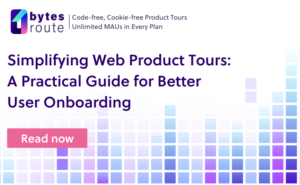The main goal of the onboarding process for new users comes down to delivering that initial instance of value.
Keep in mind that the onboarding process for each SaaS user must be different. Why? Because every SaaS product has its own distinct Aha! moment.
In this article, we will answer the most common questions in SaaS onboarding and discuss six things to consider while creating your SaaS onboarding strategy.
What is SaaS Onboarding Software?
Onboarding is the process of training individuals on how to use your products and services. It can be done through videos, mock-ups, articles, in-app tutorials, etc.
But, there is a more up-to-date way to present your product, and that is through SaaS Onboarding Software. It’s a way that helps “Software as a Service” companies improve their customer onboarding process. This method helps your users get used to your platform and gives them all the information they need to use it.
SaaS Onboarding Software can help with onboarding by integrating with your current product so that it can capture data from their usage and provide specific information to the user that is useful for their onboarding process.
NPS (Net Promoter Score) is a metric used in business to measure the degree of customer loyalty. A score of 10 on NPS means you’ve got a loyal customer, while anything under that is considered less than loyal and anything over that is considered very loyal.
Why Implement a SaaS User Onboarding Solution?
By using a SaaS onboarding solution, you will be able to grow your feature adoption rate at a faster pace. According to this article, 86% of users say they will remain loyal if onboarding and continuous education are provided.
If you have a lot of users who are new to your platform and don’t have any experience with it, then this is an excellent way for them to get up to speed on how everything works.
And, in the end, implementing a SaaS onboarding solution can save you and your team time by helping you get up and running quickly with the software. This saves your IT department from having to spend hours on end fixing problems or answering questions about how things work.
What are the Different Types of SaaS Onboarding Tools?
There are many different methods and techniques that a SaaS business can use for onboarding their customers. These are the most popular ones:
- Free trial
- Onboarding videos
- Product/platform tours
- Product documentation
- Onboarding emails
- User guides and tutorials
- Ebooks and whitepapers
The main objective of onboarding software is to give SaaS companies platform product tours that are simple to create and present. The onboarding product provides a potential client with the tools they need to educate their audience about the product, increasing the likelihood that they will be successful in their efforts to persuade the visiting users to adopt their digital platform and, even more importantly, convert them into actual clients.
Thus, onboarding software is an entire system created to assist your SaaS company in offering a product tour for your platform or service. It serves as a roadmap for new users, showing them how to use your platform effectively and with confidence.
How to Develop a Custom SaaS Onboarding Plan?

To make sure that new customers have a good experience with SaaS, you need an onboarding plan. There are many things to consider when developing an onboarding plan. One must consider the user’s interaction with the product, what type of user they are, and how they will use the product.
There are a few things that you need to consider when developing a SaaS onboarding plan:
1. Understand your customers’ needs.
2. Understand the needs of your product
3. Develop an onboarding strategy
4. Recognize and address pain points.
5. Use the platform to effectively capture each stage of the customer’s journey.
6. Collect feedback from customers and iterate based on their suggestions.
What to remember from this SaaS onboarding post?
We have discussed the importance of onboarding tools for SaaS businesses. We’ve looked at the various types of onboarding tools that are available and how they can benefit your business.
Now, let’s see what you shouldn’t forget!
- Use empty states wherever possible in your products. These “blank states” are a fantastic way to naturally encourage user involvement.
- Make sure to incorporate customizations in the onboarding process if your product has a variety of user profiles or use cases.
- Get users to that first “Aha!” moment as quickly as you can in the onboarding journey.
- Make sure your value proposition is clear on your landing page since the onboarding process begins there.
- Push for activation during the registration process if your product needs a significant integration before you can demonstrate value.
We hope that you found this article informative and helpful. If you are looking for an effective onboarding tool for your SaaS business, then we recommend you try out Bytes Route for free today!






